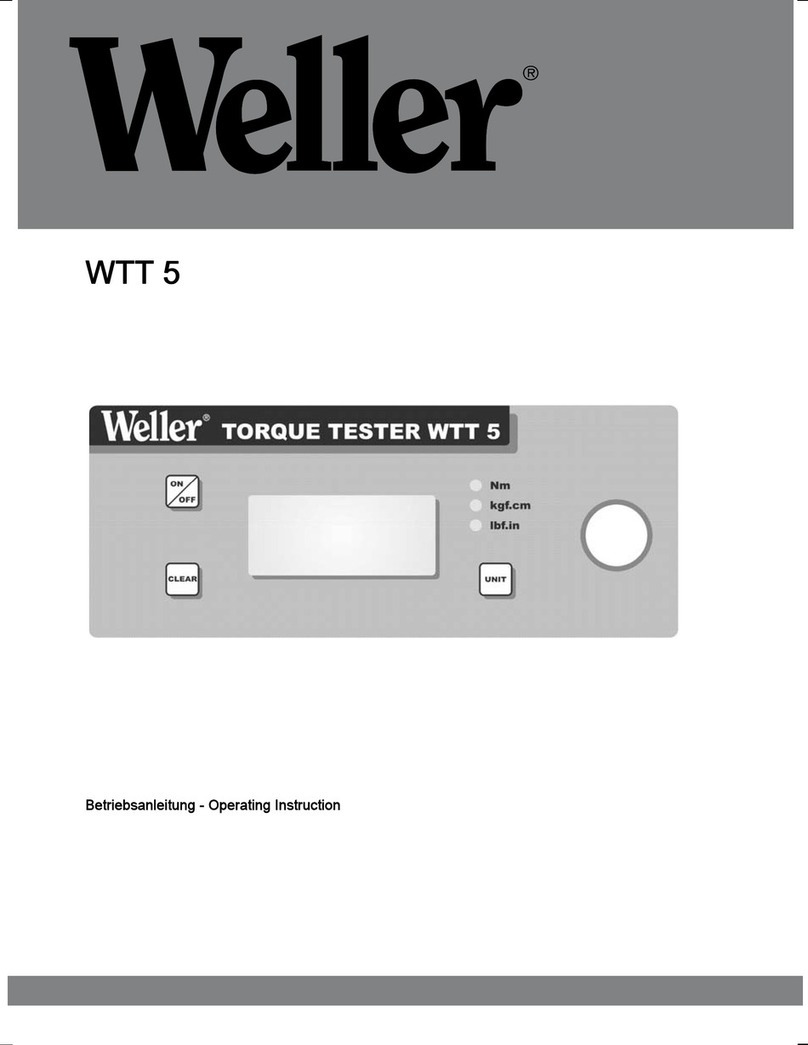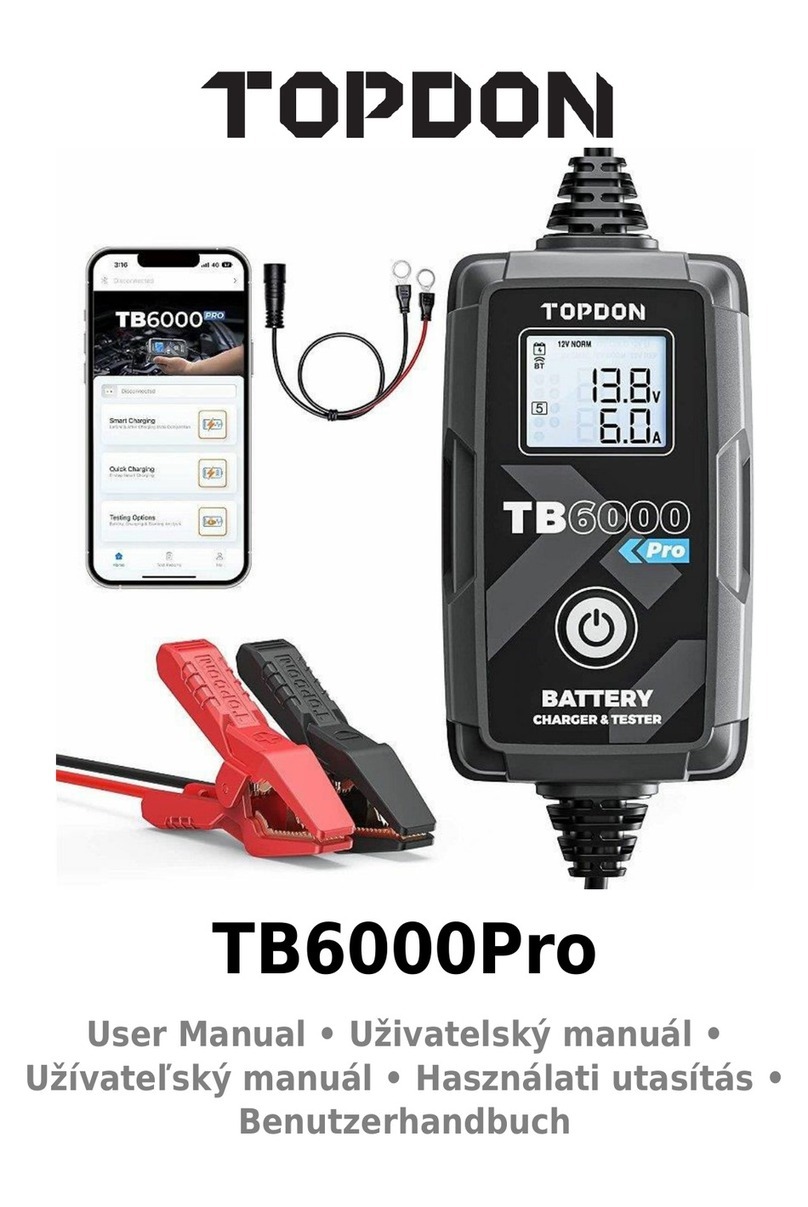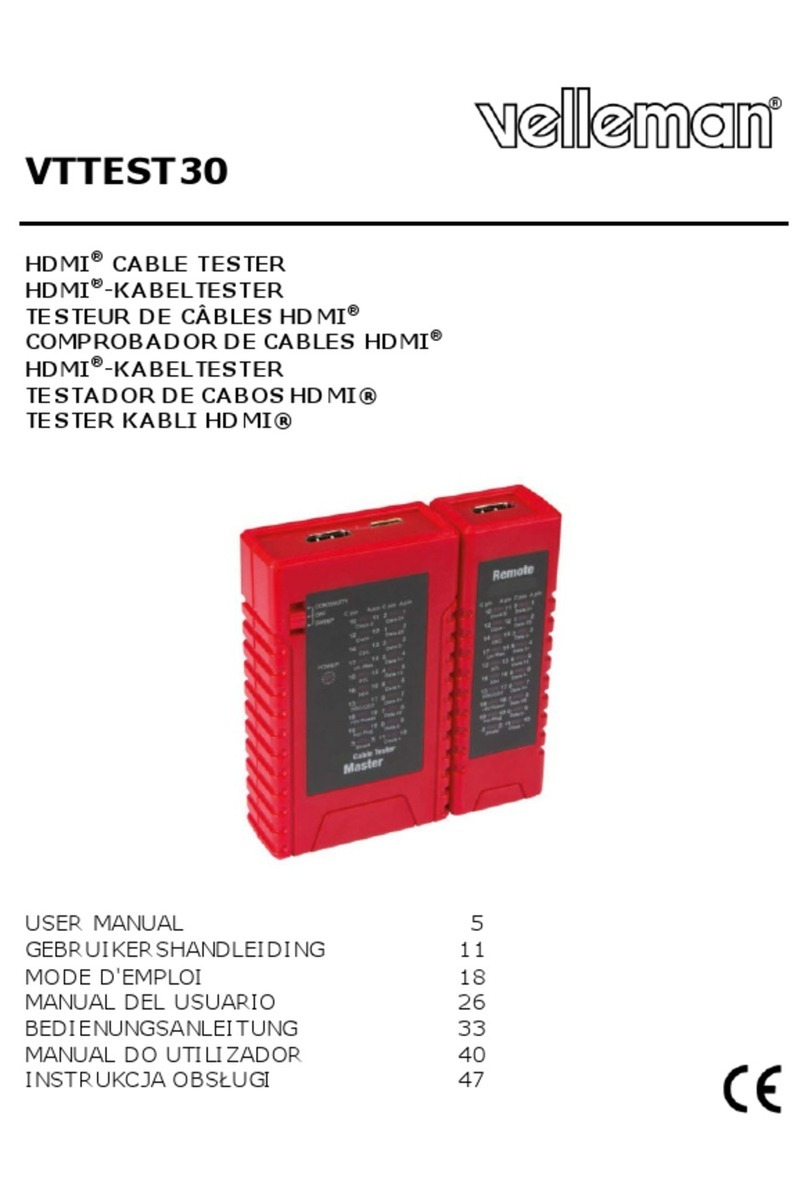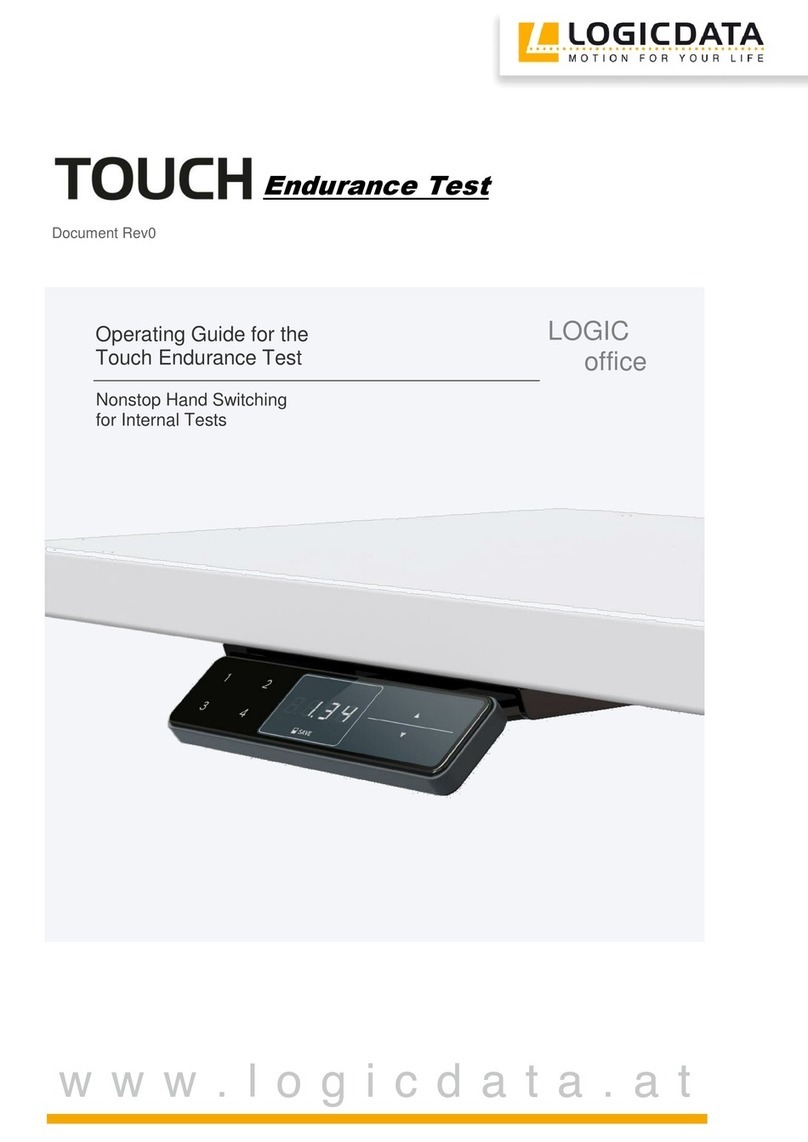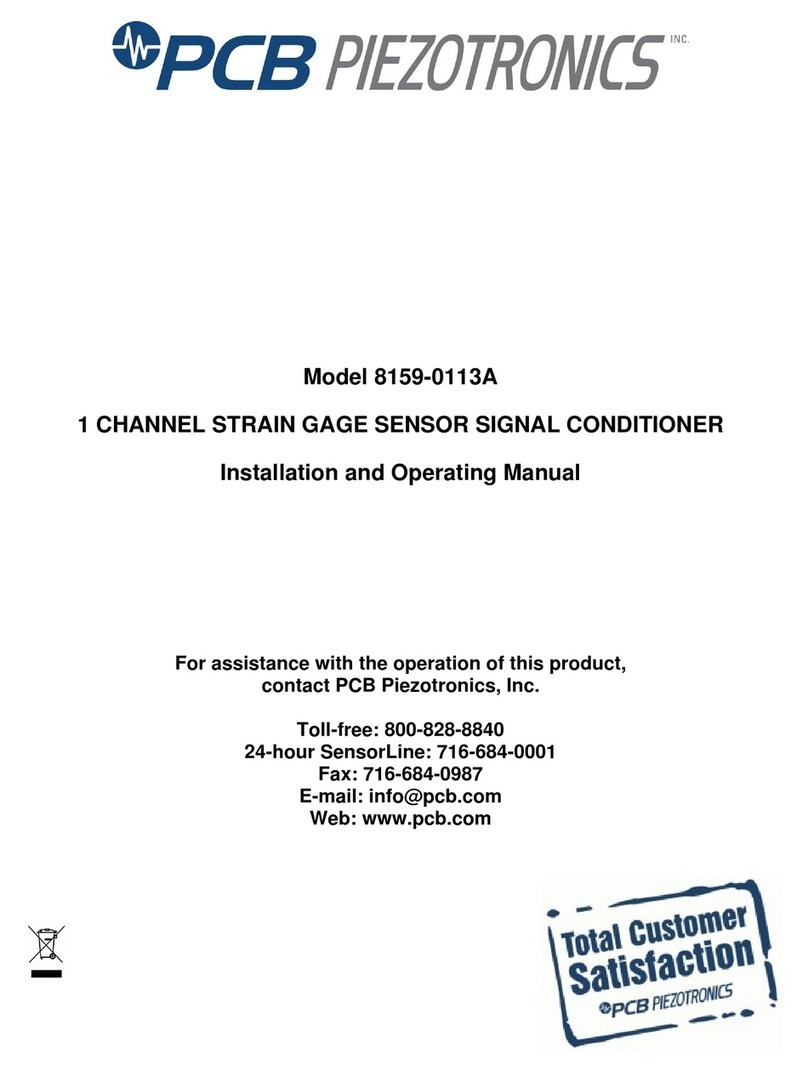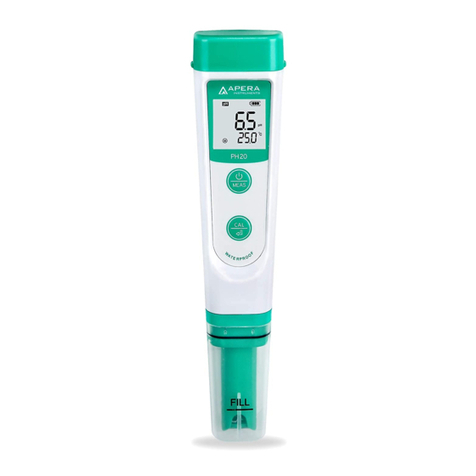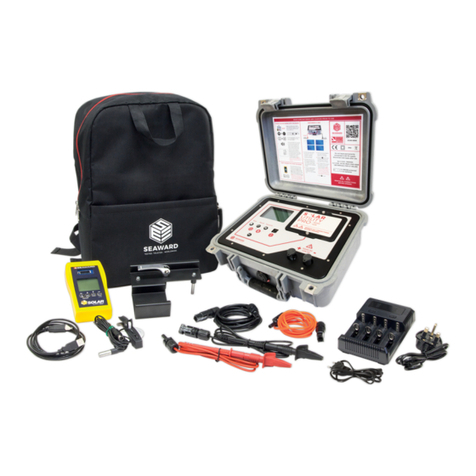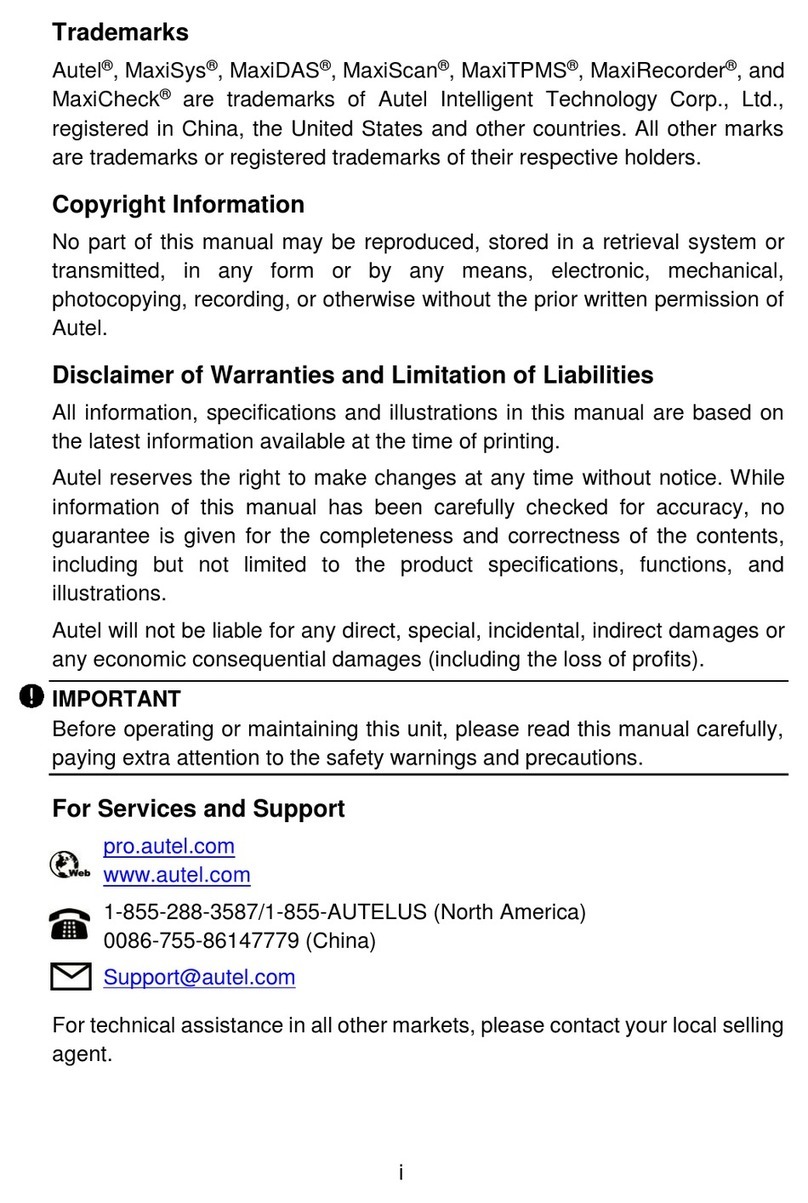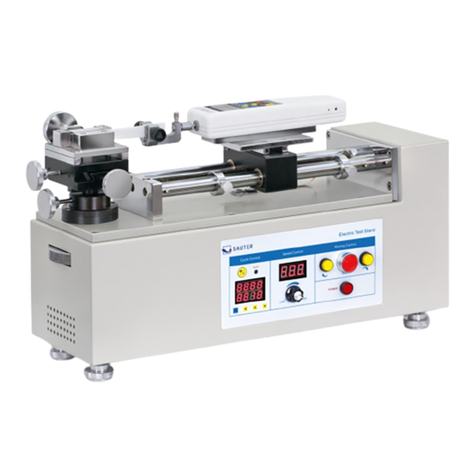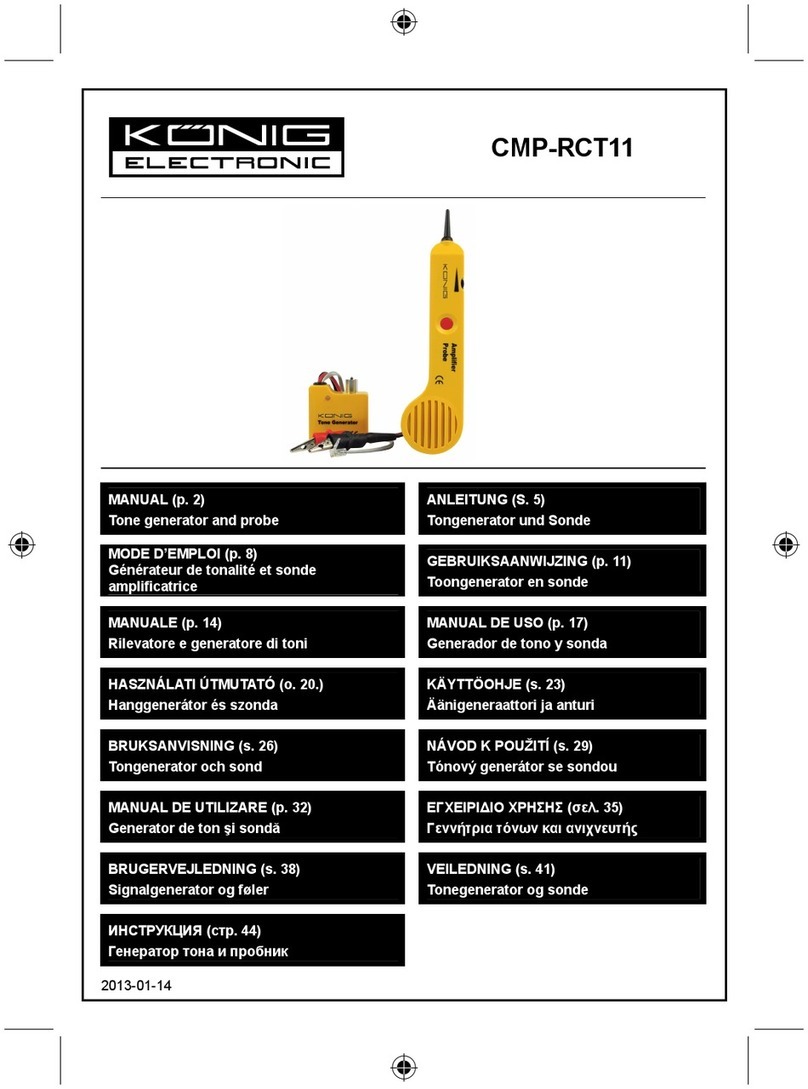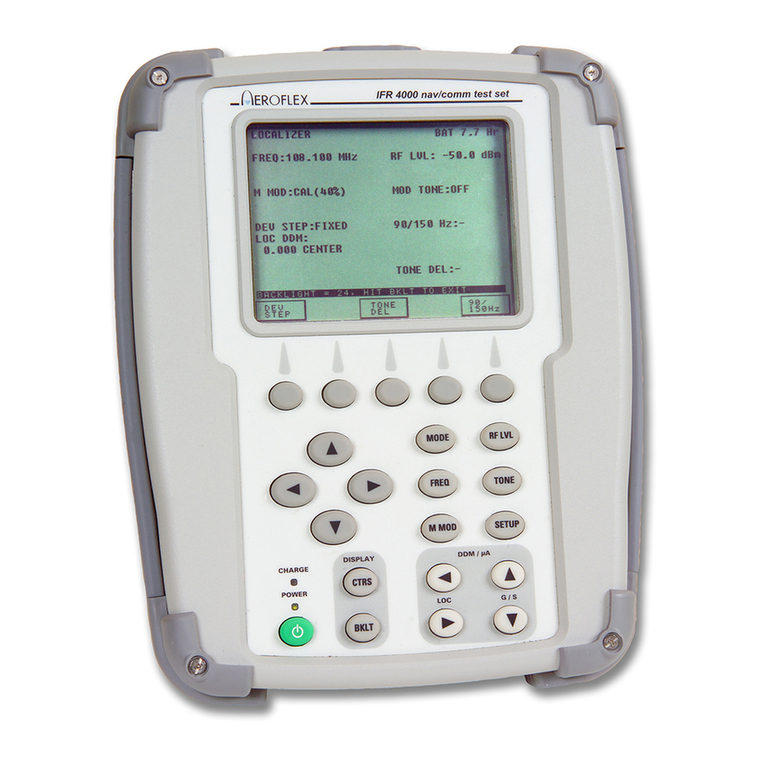DER EE DE-5000 User manual

INSTRUCTION MANUAL
DUAL DISPLAY L C R METER
Model : DE-5000
Thank you for purchasing our products. Please read this
instruction manual before using the meter and keep it
properly for contingent use.
- 1 -
Table of Contents
I. Introduction…………………………................. 03
II. Measuring Principle Introduction………… 04 ~ 07
III. Panel Illustration………................................ 08 ~ 10
IV. LCD Display Illustration………………..……… 11 ~ 12
V. Operation Instructions………………..……….. 13 ~ 34
1. Power ON/OFF …………………….…………. 13 ~ 14
2. CAL ……………………………………………. 15 ~ 17
3. LCR AUTO …………………………………….. 18 ~ 20
4. Inductance / Capacitance / Resistance
Measurement…………………………………. 20 ~ 21
5. FREQ ………………………………………….. 22 ~ 23
6. Backlight ………………………………………. 23
7. SORTING / SETUP / ENTER ……………..... 23 ~ 25
8. PC ……………………………………………… 26
9. D/Q/ESR/ș…………………………………….. 27 ~ 28
10.SER/PAL ………………………………………. 29
11.REL ……………………………………………. 30 ~ 31
12.HOLD …………………………………………... 32
VI. Replacing Batteries……………..……………… 33
VII. General Specification……………..…………… 34
VIII. Electrical Specification……………..…………. 35 ~36

- 2 -
Electrical Symbol
Risk of Danger. Important information.
See Manual.
AC/DC power adaptor input polarity
Current battery capacity indicator
Warning
ƔDischarge test device before measuring.
ƔDo not open the case of meter during measurement.
ƔAfter measurement, power off the meter. As there will be
slight power consumption under auto power off mode.
ƔTake the batteries out of the meter if it will be left idle for a
long time.
ƔDo not use organic solvent to clean the meter. Wipe it with
a soft cloth, if necessary.
Ɣmeans battery capacity is full. Once is
displayed which indicates power is low for operation and
please replace battery immediately to secure the accuracy
in specification.
- 3 -
I. Introduction
This LCR Meter is a 19999/ 9999 counts dual display, high
accuracy LCR meter, which could measure Inductance/
Capacitance/ Resistance with secondary parameters including
dissipation factor (D), quality factor (Q), phase angle (ș),
equivalent series/ parallel resistance (ESR or Rp).
This LCR Meter is fully auto ranging operation for AC
impedance & DC resistance measurement. The user could
measure the L/C/R components directly in “AUTO-LCR
“ smart mode without selecting the function key.
Components could be measured in series or parallel mode
according to the DUT (device under test) impedance
automatically.
User could select the desired test frequencies of
100Hz/120Hz/1kHz/10kHz /100kHz.
The “SORTING ” mode could help the user to make a quick
sort for a bunch of components.
The LCD display with the backlight for easy reading in dark
places.
With a 9V battery operation is standard for the meter, but a DC
9V adaptor can also be used as an optional power input.
The test data can be transferred to PC through an optional full
isolated optical USB-IR interface.

- 4 -
II. Measuring Principle Introduction
Impedance parameter introduction
䎷䏋䏈䎃 䏌䏐䏓䏈䏇䏄䏑䏆䏈䎃 䏆䏒䏑䏖䏌䏖䏗䏖䎃 䏒䏉䎃 䏕䏈䏖䏌䏖䏗䏄䏑䏆䏈䎃 䎋䏕䏈䏄䏏䎃 䏓䏄䏕䏗䎌䎃 䏄䏑䏇䎃 䏕䏈䏄䏆䏗䏄䏑䏆䏈䎃
䎋䏌䏐䏄䏊䏌䏑䏄䏕䏜䎃 䏓䏄䏕䏗䎌䎑䎃 䎩䏒䏕䎃 䏈䏛䏄䏐䏓䏏䏈䎏䎃 䎽䏖䎃 䏕䏈䏓䏕䏈䏖䏈䏑䏗䏖䎃 䏗䏋䏈䎃 䏌䏐䏓䏈䏇䏄䏑䏆䏈䎃 䏌䏑䎃
䏖䏈䏕䏌䏈䏖䎃䏐䏒䏇䏈䎑䎃䎽䏖䎃䏆䏄䏑䎃䏅䏈䎃䏇䏈䏉䏌䏑䏈䏇䎃䏄䎃䏆䏒䏐䏅䏌䏑䏄䏗䏌䏒䏑䎃䏒䏉䎃䏕䏈䏖䏌䏖䏗䏄䏑䏆䏈䎃䎵䏖䎃䏄䏑䏇䎃
䏕䏈䏄䏆䏗䏄䏑䏆䏈䎃䎻䏖䎑䎃䎬䏗䎃䏄䏏䏖䏒䎃䏆䏒䏘䏏䏇䎃䏅䏈䎃䏇䏈䏉䏌䏑䏈䏇䎃䏄䏖䎃䏄䎃䏟䎽䏟䎃䎋䏟䎽䏟䎃䎠䎃 䎵䏖䎕䎃䎎䎃䎻䏖䎕䎃 䎌䎃
䏒䏉䎃䏐䏄䏊䏑䏌䏗䏘䏇䏈䎃䏚䏌䏗䏋䎃䏄䎃䏓䏋䏄䏖䏈䎃䏄䏑䏊䏏䏈䎃䕠䎑䎃
Zs = Rs + jXs or |Zs|
И
ș
Rs = |Zs| cosș
Xs = |Zs| sinș
Xs/Rs = tanș
ș= tan-1(Xs/Rs)
- 5 -
If ș> 0, the reactance is inductive. In other words, if ș< 0, the
reactance is capacitive.
There are two types for reactance. The one is the inductive
reactance XL and the other is the capacitive reactance XC.
䎃
䎷䏋䏈䏜䎃䏆䏒䏘䏏䏇䎃䏅䏈䎃䏇䏈䏉䏌䏑䏈䏇䎃䏄䏖䎝䎃 䎃
䎋
䏉䎃
䎠䎃䏖䏌䏊䏑䏄䏏䎃䏉䏕䏈䏔䏘䏈䏑䏆䏜䎌䎃 䎃
XL = 2 ʌf L䎃䎃䎃䎃䎃䎋䎯䎃䎠䎃䎬䏑䏇䏘䏆䏗䏄䏑䏆䏈䎌䎃䎃
XC =1/ (2 ʌf C)䎃 䎃 䎋䎦䎃䎠䎃䎦䏄䏓䏄䏆䏌䏗䏄䏑䏆䏈䎌䎃 䎃
Measurement mode
The impedance could be measured in series or parallel
mode. The impedance Z in parallel mode could be represented
as reciprocal of admittance Y. The admittance could be defined
as Y = G + jB. The G is the conductance and the B is the
susceptance.
䎃
Rs: Resistance in series mode
Xs: Reactance in series mode
Cs: Capacitance in series mode
Ls: Inductance in series mode
Rp: Resistance in parallel mode
Xp: Reactance in parallel mode
Cp: Capacitance in parallel mode
Lp: Inductance in parallel mode
Y = 1/Z = 1/Rp + 1/jXp = G+jB

- 6 -
There are two factors to provide the ratio of real part and
imaginary part. Usually the quality factor Q is used for
inductance measurement and the dissipation factor D is used
for capacitance measurement. D factor is defined as a
reciprocal of Q factor.
Q = 1 / D = tanș
Q = Xs / Rs = 2ʌf Ls / Rs = 1 / 2ʌf Cs Rs
Q = B / G = Rp / | Xp | = Rp / 2ʌf Lp = 2ʌf Cp Rp
Actually, Rs and Rp are existed in the equivalent circuit of
capacitor or inductor. If the capacitor is small, Rp is more
important than Rs. If capacitor is large, the Rs is more
important also. Therefore, use parallel mode to measure lower
value capacitor and use series mode to measure higher value
capacitor. For inductor, the impedance relationship is different
from capacitor. If the inductor is small, Rp is almost no effect. If
inductor is large, the Rs is no effect also. Therefore, use series
mode to measure lower value inductor and use parallel mode to
measure higher value inductor.
Open/short calibration
process to get the better accuracy for high/low impedance
measurement. The purpose of open/short calibration is to
reduce the parasitic effect of the test fixture.
- 7 -
ZMis defined as total impedance measured to DUT
( device under test ) by the special test fixture which has some
parasitic impedance.
ZM = (Rs + jȦLs) + ((Go+jȦCo)-1 || ZDUT)
ZDUT is the target impedance user wants to realize. It is
necessary to use the open/short calibration process to cancel
the effect of Rs+jȦLs and Go+jȦCo.
Equivalent circuit

- 8 -
Panel Illustration
Front panel Side
“GUARD” provides shield for DUT ( device under test ),
improvised test leads or equipments situated at places where
with high interference.
- 9 -
ij
ijĴįġ
ŕōĮijĴ Guard Line
ijijįġ
ŕōĮijij SMD
tweezers (optional)
ijIJįġ
ŕōĮijIJ Alligator
Test Lead Case
Rear
IR to USB case
(optional)

- 10 -
1. LCD display
2. POWER To power on/off the instrument
3. LCR AUTO LCR auto mode, Inductance,
Capacitance, Resistance and DC
resistance measurement selection key
4. FREQ Testing frequency selection key
5. Backlight display
6. SORTING Sorting mode control key
7. PC UART output control
8. CAL Open/Short calibration mode
9. D/Q/ ESR/șD/Q/ ESR/șparameters selection key
10. SETUP Setup menu control key
(in sorting mode )
11. SER/PAL Series and Parallel selection key
12. ENTER Setup menu control key
(in sorting mode )
13. REL% Relative mode
14. HOLD Data hold
15. Input sockets and Terminals
16. AC/DC power adaptor
17. Battery cover
18. Tilt-Stand
19. IR to USB Slot
20. IR to USB case (optional)
21. TL-21 Alligator Test Lead Case
22. TL-22 SMD tweezers (optional)
23. TL-23 Guard Line
- 11 -
III. LCD Display Illustration
LCD Display.
1. Sorting Sorting function is enabled
2. Tol Tolerance indication in sorting mode : ±0.25%, ±0.5%,
± 1%, ±2%, ±5%, ±10%, ±20%, & +80%-20%
3. kHz Testing frequency indication –
1kHz,10kHz,100kHz,100Hz & 120Hz
4. PC Communication is active
5. Battery capacity indication
6. Range Range selection is enabled on setup menu of sorting
mode
7. Auto Auto range for L, C or R measurement
8. LCR Checking for L/C/R mode automatically
9. ǻRelative function is enabled
10. Ls/Lp Inductance in series or parallel mode is active
11. Cs/Cp Capacitance in series or parallel mode is active
12. Rs/Rp AC Resistance in series or parallel mode is active
13. DCR DC resistance mode is selected

- 12 -
14. D/Q/șDissipation factor, Quality factor or Phase angle is
active for L/C measurement mode
15. Rp AC Resistance in parallel mode is active
16. Cal Open/Short calibration mode
17. HOLD Data Hold
18. APO Auto power off mode
19. ESR Series equivalent resistance mode
20. Secondary Display
21. ° Phase angle unit
22. MkȍUnit for Resistance (ȍ, kȍand Mȍ)
– on secondary display
23. Unit for Capacitance ( pF, nF, ȝF and mF )
– on secondary display
24. Unit for Inductance ( ȝH, mH and H)
– on secondary display
25. % The percentage display in relative mode
– on secondary display
26. Primary Display
27. MkȍUnit for Resistance ( ȍ, kȍand Mȍ)
– on primary display
28. Unit for Inductance ( ȝH,mH and H)
– on primary display
29. Unit for Capacitance ( pF,nF,ȝF and mF )
– on primary display
30. Bar-graph display
ySpecial Indication Characters
ġ
ġ
Indicates short calibration
ġ
Indicates open calibration
- 13 -
IV.Operation Instructions
To access optimum precision for all L, C and R measurements
especially at the highest and the lowest ranges, please use the
alligator test leads (TL-21) or improvised test leads applying to the
measurement for OPEN and SHORT calibration (refer to page
15~17) to reduce the parasitic effect of the test fixture before going
forward the measurement.
To secure the accuracy in specification, please only connect DUT
(device under test) to measuring socket or use TL-21 (standard
accessory) or TL-22 (optional accessory) for measurement.
If use improvised test lead for measurement please prevent using
long wire which may have incorrect result.
1. Power ON/OFF
yWhen power on, all symbols will display for 2 seconds.
yIn Auto Power off mode, APO will be shown on the display. It
will power off automatically, if without any key operation or
measurement for 5 min. Buzzer will beep three times to
remind auto power off is ready to activate and then “OFF”
display to power off.

- 14 -
yThe default setting is LCR auto mode at test frequency 1kHz.
yBattery condition is detected every second and displayed.
suggests battery capacity is full suggests power is
low and needs to be replaced a new battery.
yIf the key functions, the buzzer beeps once when key is
pressed. If the key has no function, the buzzer beeps twice
when key is pressed.
Using adaptor as power supply,
Auto Power off function disables
automatically and “APO”
disappears.
yAuto power off function is disabled automatically, when
using a 9V adaptor as the alternative power supply.
Using 9V- battery as power
supply, “APO” displays.
yAuto power off function enables when using a 9V-battery as
power supply.
- 15 -
2. CAL
yThis function enables the LCR meter’s internal parameters
and external connector residues to be calibrated to have
better and precise measurements.
yTo make better precision measurements on extremely high
or low impedance ranges of L,C,R, it is highly recommended
that do OPEN/SHORT calibration to reduce the parasitic
effect of the test fixture before measuring.
yNote: Remove any leads or DUT ( device under test ) from
the meter during this procedure. If leaving them connected,
will add impedance to the circuit causing the calibration to
fail indicated by FAIL showing on the display.
Ex. Operation for open and
short calibration with TL-21 Ex. Operation for open and short
calibration with .TL-22
Open Cal.
Short Cal.
Open Cal. Short Cal.
yConnect TL-21 (or improved test leads applied to the
measurements) and press “CAL” key > 2 seconds to enter
the calibration mode ĺOPEN ready ĺOPEN calibration ĺ
SHORT ready ĺSHORT calibration. Follow below
procedure to complete the calibration.
yWhen start the open or short calibration, it will have 30
seconds countdown shown on the display.

- 16 -
yIf calibration is completed, PASS or FAIL appears on the
primary display.
yIf both calibrations are passed, press ”CAL” key again to
store the calibration value to EEPROM.(Electrically Erasable
Programmable Read-Only Memory).
Display the measurement reading
Press “ CAL ” key for 2sec.
Enter to open calibration mode
Press “ CAL ” key
Start the open calibration with
30-seconds countdown
OPEN calibration is completed.
Pass or Fail will appear on the
primary display
* If FAIL, run the procedure from
the first step again.
Press “ CAL ” key
- 17 -
Enter short calibration mode.
* Short alligator test leads.
Press “ CAL ” key
Start the short calibration with
30-seconds countdown
SHORT calibration is completed
PASS or FAIL will appear on the
primary display
* If FAIL, run the procedure from
the first step again.
Press “ CAL ” key
Calibration is completed
Return to testing mode.
When open or short calibration
fails. “FAIL” will appear on the
primary display.
yIf fails in calibration, please double check the DUT( device
under test ) is in the right calibration position and resume the
open and short calibration procedures.

- 18 -
3. LCR AUTO
yThe “LCR AUTO” key selects the primary parameter
measurement function. Each press of the key will select
either Auto-LCR mode, Auto-L mode, Auto-C mode, Auto-R
mode or Auto-DCR mode*1.
yThe default setting is LCR Auto*1 mode which can check the
type of Impedance smartly and enter to the measurement
function automatically.
In LCR AUTO test mode
Press “LCR AUTO ” key
Enter Auto L mode
Press “LCR AUTO ” key
Enter Auto C mode
Press “LCR AUTO ” key
- 19 -
Enter Auto R mode
Press “LCR AUTO ” key
Enter DCR mode
Press “LCR AUTO ” key
Back to LCR AUTO test mode
yWhen Auto-L or Auto-C mode is selected, the impedance
measurement is auto ranging.
yThe primary display will show the parameter of inductance,
capacitance or resistance of DUT ( device under test ).
yThe secondary display will show the quality or dissipation
factor of DUT ( device under test ).
yThe secondary parameter will be based on the L/C/R
measurement. It means that (L + Q), (C + D)*2, (R + ș)*3 are
combined in one group respectively.
*1: If |Q| < 0.2, the Auto-R mode will be selected automatically. The
parameter on sub-display is ș.
If Q Њ0.2, the Auto-L mode will be selected automatically. The
parameter on sub-display is Q.
If Q Њ-0.2, Auto-C mode will be selected automatically. The
parameter on sub-display is D.

- 20 -
If C < 5pF. The parameter on sub-display is Rp.
*2: When LCR Auto mode is active, the secondary parameter will show
the equivalent resistance in parallel mode (Rp) to replace the D
factor if the C value of DUT is less than 5pF.
*3: LCR AUTO mode only. In Auto-R mode or DCR mode, the
secondary parameter is not available.
4. Inductance / Capacitance / Resistance Measurement
yPower on the meter, the default testing mode is LCR Auto
mode that can enter to the L/C/R measurement
automatically.
yEach press of the key will select either Auto-LCR mode,
Auto-L mode, Auto-C mode, Auto-R mode or Auto-DCR
mode.
a. Insert DIP component leads to
the sockets directly. or
b. To measure DIP and SMD
component by Alligator Test
Lead Case (TL-21)
If required, Guard line (TL-23) can
provide shield for DUT (device
under test ) preventing from
interference when measuring high
impedance component
Alligator Test Lead
Case (TL-21)
- 21 -
c. To measure SMD component by SMD tweezers (TL-22,
option).
ġ
ɏʳTo make better precision measurements on extremely high or
low impedance ranges of L,C,R, it is highly recommended
that do OPEN/SHORT calibration before testing. ġ
Warning : To avoid electric shock, please discharge the capacitor
before testing.
SMD Tweezers
(TL-22)
If required, Guard line (TL-23) can
provide shield for DUT (device
under test ) preventing from
interference when measuring high
impedance component

- 22 -
5. FREQ
yThe “FREQ” key selects the testing frequency. Each press of
the key will select either 1kHz, 10 kHz, 100kHz, 100Hz or
120Hz, total 5 frequency for selection.
yThe default frequency setting is 1kHz.
The testing frequency is 1kHz.
Press “FREQ ” key
The testing frequency is 10kHz.
Press “FREQ ” key
The test frequency is 100kHz.
Press “FREQ ” key
The test frequency is 100Hz.
Press “FREQ ” key
- 23 -
The test frequency is 120Hz.
Press “FREQ ” key
Back to test frequency 1 kHz
yThe LCR impedance scale ranges are based on the test
frequency.
6. Backlight
yPress“ ”key to toggle backlight on/off.
yThe backlight will be disabled in 60 seconds automatically from
the last operation of pushing any key or measurement.
7. SORTING / SETUP / ENTER
yThese key functions are disabled in LCR AUTO mode.
yPress “LCR AUTO ” key to select primary parameter
measurement function.
yIn measurement (connect DUT), press “ SORTING ” key to
enter the sorting mode which will be set to 2000 digits display
automatically. If the reading is OL or less than 200 counts, the
sorting function is disabled.

- 24 -
yThe primary display will show PASS or FAIL which based on
whether the impedance measured exceeds tolerance range.
The secondary display will show the measurement reading.
yWhen sorting mode is active, operate “ SETUP ” key along with
“Ż/ Ź” key, “Ÿ/ ź” key and “Enter” key to set the reference
value, range and tolerance.
yWhen the setup is finished, press “ ENTER ” key to confirm.
Figure : Setting up the reference value for sorting
Display the measurement reading
Press “ SORTING ” key
The measurement reading is
shown on the secondary display.
Press “ SETUP ” key
“Range” will appear and flash.
Push “Ż/ Ź” key to select the
position of decimal point and units
based on the components you
measure
Press “ ENTER ” key
- 25 -
Last digit will flash
Press “Ż/ Ź” key to select the
desired digit.
Press “Ÿ/ ź” key to adjust value.
Press “ ENTER ” key
“Tol ±” will flash.
Press“Ż/ Ź”key to select Tol.
value : Each press of the key will
select either
±1%,±2%,±5%,±10%,
±20%, -20%+80%, ±0.25% or
±0.5%.
Press “ ENTER ” key
Setup is completed.
ƔIf DUT ( device under test ) is
in the specified Tol % , buzzer
beeps once and the primary
display will show “PASS”.
yIf DUT ( device under test ) is out
of the specified Tol %, the
primary display will show
“ FAIL ”.

- 26 -
IR to USB case
USB socket
8. PC
(IR to USB case is optionel. Measuring
data can be transferred to PC with it. )
ySnap on IR to USB case and connect
with USB cable to PC.
yPress “ PC ” key to start data
transmission, and the “PC” will appear on
display. Press the “ PC ” key again to
cancel the transmission.
Display the measurement reading
Press “ PC ” key
PC communication is active.
“PC” will appear on the display
Press “ PC ” key
“PC” disappear on the display
when PC communication is
inactive
- 27 -
9. D/Q/ESR/ș
yIn LCR Auto mode, this key has no function
yThe “D/Q/ESR/ș”key selects the secondary parameter
measurement function. Each press of the key will select
either dissipation (D), quality (Q), ESR or phase angel (ș).
Example : In Cs testing mode
Secondary display parameter is
D.
Press “ D/Q/ESR/ș” key
Secondary display parameter is
Q.
Press “ D/Q/ESR/ș” key
Secondary display parameter is
ESR.
Press “ D/Q/ESR/ș” key

- 28 -
Secondary display parameter is
ș.
Press “ D/Q/ESR/ș” key
Back to parameter D
measurement
ƔD/Q/ESR/șsetting is not applied to resistance
measurement- Auto-R mode and DCR mode.
In Auto-R mode, no parameter
measurement on the secondary
display.
In DCR mode, no parameter
measurement on the secondary
display.
- 29 -
10.SER/PAL
yIn LCR Auto mode, this key has no function.
yPress the “SER/PAL” key to select parallel or series mode,.
yWhen any one of primary parameter measurement function
is selected, parallel or series mode will be selected
automatically based on the total equivalent impedance
measured.
yIf the impedance is more than 100kȍ, will be in the parallel
mode automatically. Lp, Cp or Rp appears on the display.
yIf the impedance is less than 100kȍ, will be in the series
mode automatically. Ls, Cs or Rs appears on the display.
Example : In Cs and Cp testing mode
When measure capacitance in
series mode.
“Cs” will appear.
Press “SER/PAL ” key
When measure capacitance In
Parallel mode.
“Cp” is shown.
Press “SER/PAL ” key
Back to Series mode.
“Cs” is shown.
yThe annunciators for Ls/Lp/Cs/Cp/Rs/Rp will be indicated based
on LCR measurement mode.

- 30 -
11.REL
yIn LCR Auto mode, this key has no function.
yPress the “REL” key to enter relative mode. The value on the
display will be stored as reference value and “ǻ” annunciator
will appear.
yThe secondary display will show the percentage of reference
value for all subsequent measurements
Display the measurement
reading
Ex. 669.3 nF
Press “REL” key
“ǻ” appear
The reading on the display is
stored as reference value.
0.0% is shown on the secondary
display( since the measured
value and the reference are the
same at this point )
Remove the current DUT
( device under test ) and insert
another one
The new reading is shown on the
primary display.
Minus ***% is shown on the
secondary display.
- 31 -
Remove the current DUT
( device under test ) and insert
another one
The new reading is shown on the
primary display.
***% is shown on the secondary
display.
(All subsequent measurements
will be displayed as a percentage
value to the stored value )
Press “REL” key again
“ǻ” flash
The reference value display on
primary display.
yREL% = (DCUR – DREF) / DREF * 100%.
*DCUR = Current DUT(device under test), DREF = Reference
DUT (device under test )
yThe percentage range is from -99.9% to 99.9%. When the
new measurement is double than reference value. OL% will
be shown on the secondary display.
yPress “ REL ” key for more than 2 sec. to exit Relative Mode.

- 32 -
12.HOLD
yPress the “HOLD” key to freeze the reading on the primary
display and “HOLD” will appear.
yIn the Hold mode, only key and PC key have function.
“HOLD” is shown.
yPress the “HOLD” key again, to exit the Hold mode
“Hold” disappears
- 33 -
V. Replacing Batteries
The meter is powered by a single 9V battery, with NEDA1604 ,
JIS006P and IEC6F22 carbon-zinc or alkaline battery. Alkaline
battery is recommended.
When replaces a new battery, the sign of ” “ displays. To
ensure the measuring data is within spec, it is suggested to replace
battery immediately once ” “ displays.
Warning
zSwitch off the meter. Remove all test leads and external adaptor
before opening the case.
zBe sure to install the new batteries with correct polarities.
1. Remove tilt-stand.
2. Loosen 4 screws on battery
cover with suitable
screwdriver.
3. Then take up the cover.
4. Replace the specified battery.
5. Reverse the procedure of
step2 and step1.

- 34 -
VI.General Specification
Item Dual Display L C R Meter
Parameters Measured Ls/ Lp/ Cs/ Cp/ Rs/ R p/ D/ Q/ Ĭ/ ESR
L C R auto selection
Measuring Circuit Mode Series / Parallel mode
Displays Dual 19999/1999 display
Ranging Mode Auto
Measuring Terminals 4 - wire Sockets ( Terminals ) & Guard
Auto LCR test range:
L: 20.000ȝH ~ 2.000 KH
C: 200.00pF ~ 20.00mF
R: 20.000 ȍ~ 200.0 Mȍ
DCR: 200.00ȍ~200.0Mȍ
Test Frequency 100Hz/ 120Hz/ 1kHz/ 10kHz/ 100kHz
Backlight YES
Tolerance mode ±0.25%, ±0.5%, ± 1%, ±2%, ±5%, ±10%
, ±20%, -20%+80%
Test Signal Level 0.5 Vrms Typ.
Measuring Rate 1.2 /second, nominal
Response time Approx. 1 second/ DUT ( device under test )
Auto Power-Off 5 minutes approx. without key operation
Temperature
Coefficient 0.15 x (spec.accur.) per °C (0-18°C, 28-50°C)
Operation Temperature 0°C to 50°C; 0-70% R.H.
Storage Temperature -20°C to +60°C; 0-80% R.H.
Battery voltage
Indication
When 9V battery in good condition,
displays.
When low battery, displays. Please replace
new batteries immediately.
Standard Accessories Alligator test lead case(TL-21)ΕAC/DC AdaptorΕ
Guard Line (TL-23)ΕUser manualΕDC 9V Battery
Option IR to USB caseΕSMD Tweezers(TL-22)
Dimensions (L/W/H) 188 / 95 / 52.5 mm
Weight approx. 350g (LCR Meter only, excluding battery)
- 35 -
VII. Electrical Specification
Accuracy: ±(% of reading + number of least significant digits) at 23°C ± 5°C, <75% R.H.
1. Specifications are based on measurement performed at input sockets or terminals with Alligator
Test Lead Case (TL-21) after short & open calibration. (refer to page. 8~10 item 15)
2. DUT ( device under test ) & Test leads should be properly shielded to GUARD if necessary.
3. To make better precision measurements on extremely high or low impedance ranges of L,C,R, it is
highly recommended that do OPEN/SHORT calibration before measuring for following ranges
marked with *
Ϯʳ Resistance (Parallel / Series mode)
Range Resolution 100/120Hz 1kHz 10kHz 100kHz
20.000ȍ0.001ȍņ1.0%+3* 1.0%+3* 2.0%+3*
200.00ȍ0.01ȍ1.0%+3 0.3%+2 0.3%+2 0.6%+3
2.0000kȍ0.0001kȍ0.3%+2 0.3%+2 0.3%+2 0.6%+3
20.000kȍ0.001kȍ0.3%+2 0.3%+2 0.3%+2 0.6%+3
200.00kȍ0.01kȍ0.5%+2 0.5%+2 0.5%+2 1.0%+3
0.0001Mȍ1.0%+3 1.0%+3 1.0%+3 ņ2.0000Mȍ
(2.000Mȍ) 0.001Mȍņņņ2.0%+3*
0.001Mȍ2.0%+3* 2.0%+3* ņņ20.000Mȍ
(20.00Mȍ) 0.01Mȍņņ2.0%+3* ņ
200.0Mȍ0.1Mȍ2.0%+3* 2.0%+3* ņņ
* Do open/short calibration before measuring for above ranges with * to have better precision
measurements.
Ϯʳ DCR
Range Resolution Accuracy
200.00ȍ0.01ȍ1.0%+3*
2.0000kȍ0.0001kȍ0.2%+2
20.000kȍ0.001kȍ0.2%+2
200.00kȍ0.01kȍ0.5%+2
2.0000Mȍ0.0001Mȍ1.0%+3
20.000Mȍ0.001Mȍ2.0%+3*
200.0Mȍ0.1Mȍ2.0%+3*
* Do open/short calibration before measuring for above ranges with * to have better precision
measurements.
Ϯʳ Capacitance (Parallel / Series mode)
Range Resolution 100/120Hz 1kHz 10kHz 100kHz
200.00pF 0.01pF ņņ1.2%+5* 2.0%+5*
2000.0pF 0.1pF ņ2.0%+3* 0.3%+2 0.6%+3
20.000nF 0.001nF 2.0%+3* 0.3%+2 0.3%+2 0.6%+3
200.00nF 0.01nF 0.3%+2 0.3%+2 0.3%+2 0.6%+3
2000.0nF 0.1nF 0.3%+2 0.3%+2 0.6%+2 2.0%+5*
0.001ȝF 0.3%+2 0.6%+2 1.2%+5* ņ
20.000ȝF
(20.00ȝF) 0.01ȝF ņņņ3.0%+5 (10ȝF max.)*
0.01ȝF 0.6%+2 1.0%+3* ņņ
200.00ȝF
(200.0ȝF) 0.1ȝF ņņ3.0%+5 (100ȝF max.)* ņ
0.1ȝF 1.0%+3* ņņņ
2000.0ȝF
(2000ȝF) 1ȝF ņ1.2%+3* ņņ
20.00mF 0.01mF 1.2%+3* ņņņ
ƔIf reading <2000, unit on display is pF
* Do open/short calibration before measuring for above ranges with * to have better precision
measurements.

- 36 -
Ϯʳ Inductance (Parallel / Series mode).
Range Resolution 100/120Hz 1kHz 10kHz 100kHz
20.000ȝH 0.001ȝH ņņņ2.5%+5*
200.00ȝH 0.01ȝH ņņ1.2%+5* 0.6%+3
2000.0ȝH 0.1ȝH ņ2.0%+5* 0.6%+3 0.6%+3
20.000mH 0.001mH 1.2%+5* 1.0%+5 0.3%+2 0.6%+3
200.00mH 0.01mH 0.3%+2 0.6%+3 0.3%+2 1.2%+5*
2000.0mH 0.1mH 0.3%+2 0.3%+2 0.6%+3 ņ
20.000H 0.001H 0.3%+2 0.6%+3 1.2%+5* ņ
200.0H 0.1H 0.6%+3 1.2%+5* ņņ
2.000KH 0.001KH 1.2%+5* ņņņ
ƔIf reading <2000, unit on display is ȝH
* Do open/short calibration before measuring for above ranges with * to have better precision
measurements.
Ϯʳ Accuracy v.s. Resistance (ZDUT)
DCR 100/120Hz 1kHz 10kHz 100kHz
0.1~1ȍ1.2%+5* 1.2%+5* 1.2%+5* 1.2%+5* 2.5%+5*
1~10ȍ0.6%+3* 0.6%+3* 0.6%+3* 0.6%+3* 1.2%+5*
10~100kȍ0.3%+2 0.3%+2 0.3%+2 0.3%+2 0.6%+3
100k~1Mȍ0.6%+3 0.6%+3 0.6%+3 0.6%+3
1M~20Mȍ1.2%+5* 1.2%+5* 1.2%+5* 2.5%+5* 2.5%+5*
100k~2Mȍ
>20Mȍ2.5%+5* 2.5%+5* 2.5%+5* ņņ
* Do open/short calibration before measuring for above ranges with * to have better precision
measurements.
If D > 0.1, the accuracy should be multiplied by 2
D1
If D << 0.1 in capacitance mode ZC = 1/2ʌfC
If D << 0.1 in inductance mode ZL = 2ʌfL
Sub-display parameters accuracy
Ae = impedance (Z) accuracy
Definition: Q = 1/D & Rp = ESR * (1+1/D2)
D value accuracy De =
ʳ
Ae *(1+D)
ESRaccuracy Re=
ZM * Ae (ȍ)
ie., ZM = impedance calculated by 1/2ʌfC or 2ʌfL
Phase angle șaccuracy șe=
(180/ʌ) * Ae (deg)
Appearance and specification may be revised if needed
without prior notice.
DER EE is assessed and certificated as meeting the
requirements of ISO 9001:2000. We produce meters in
various types and specification and all our product
conforms to ISO standards. If any further inquiry needed,
please visit our website at www.deree.com.tw
HCA500000-00020
Table of contents
